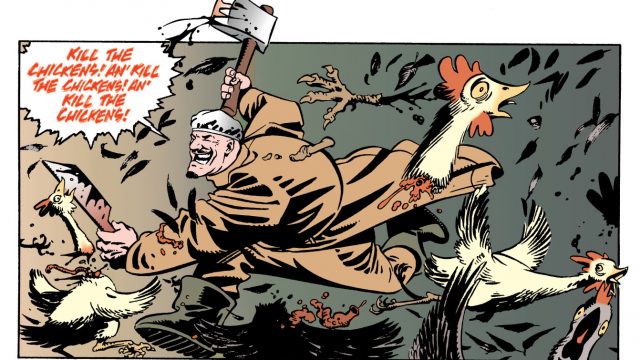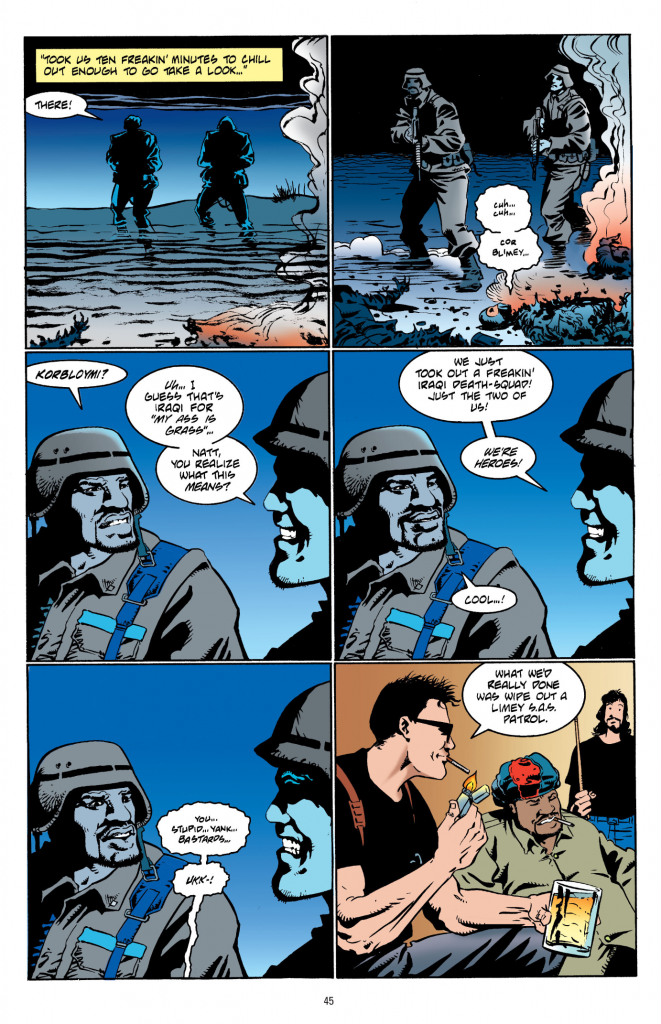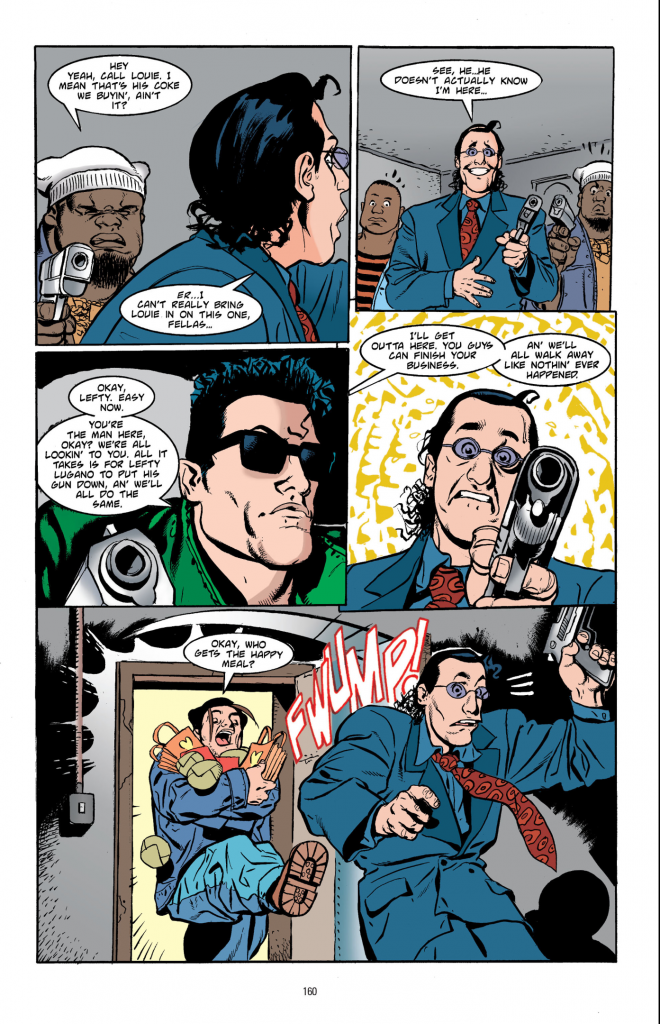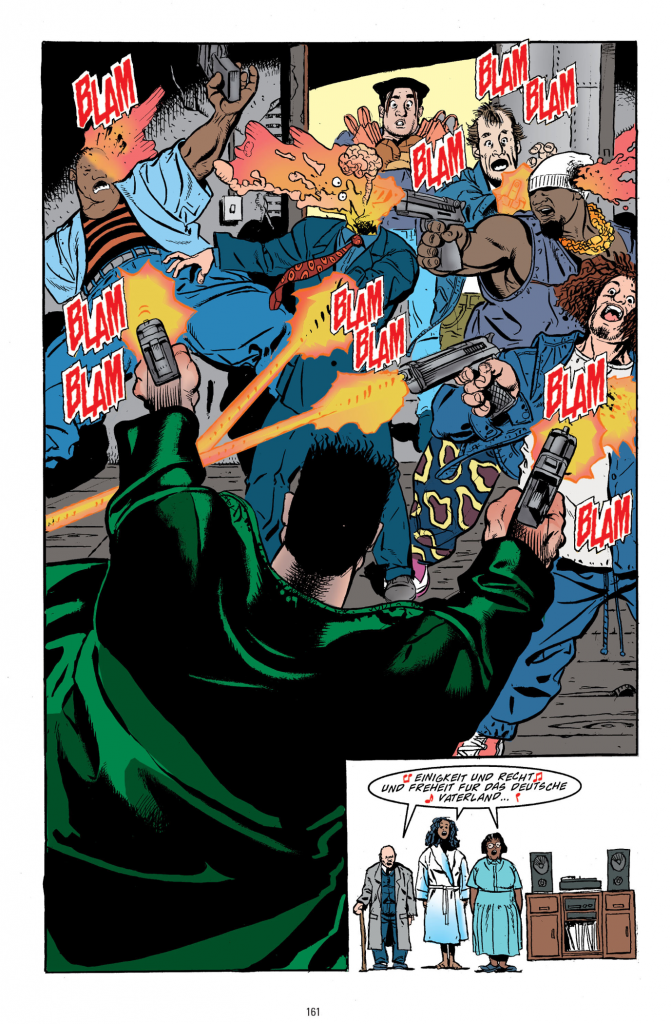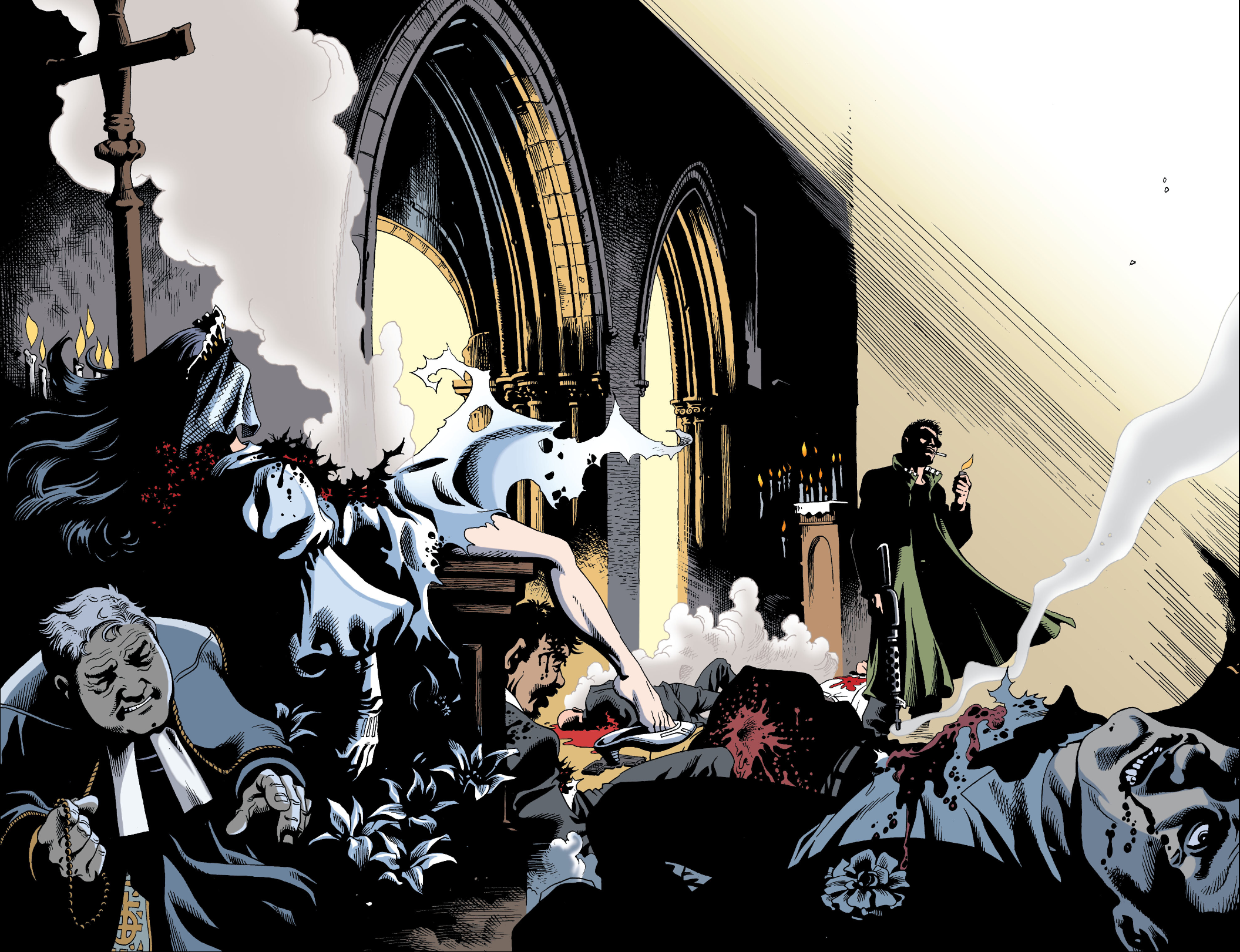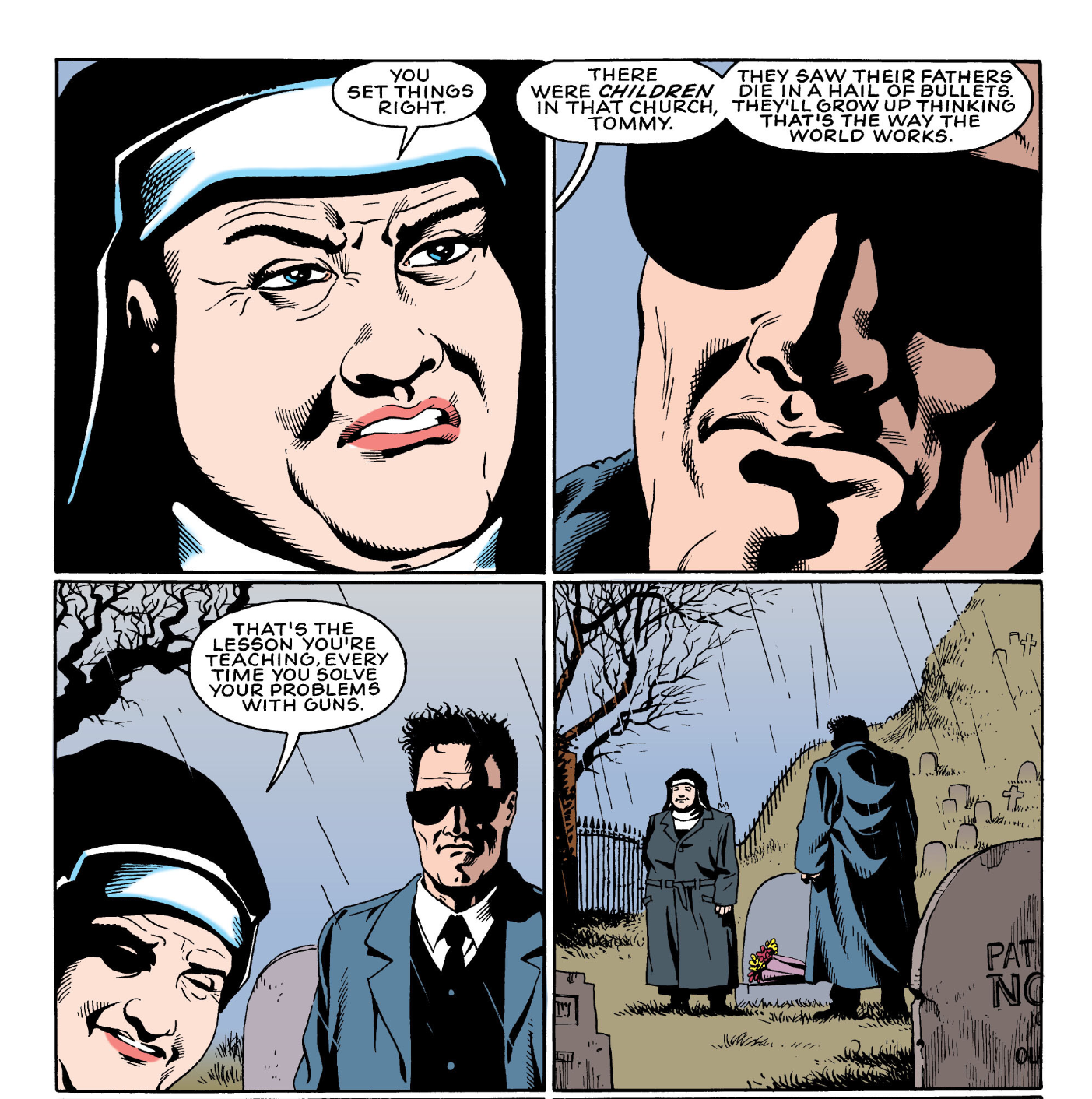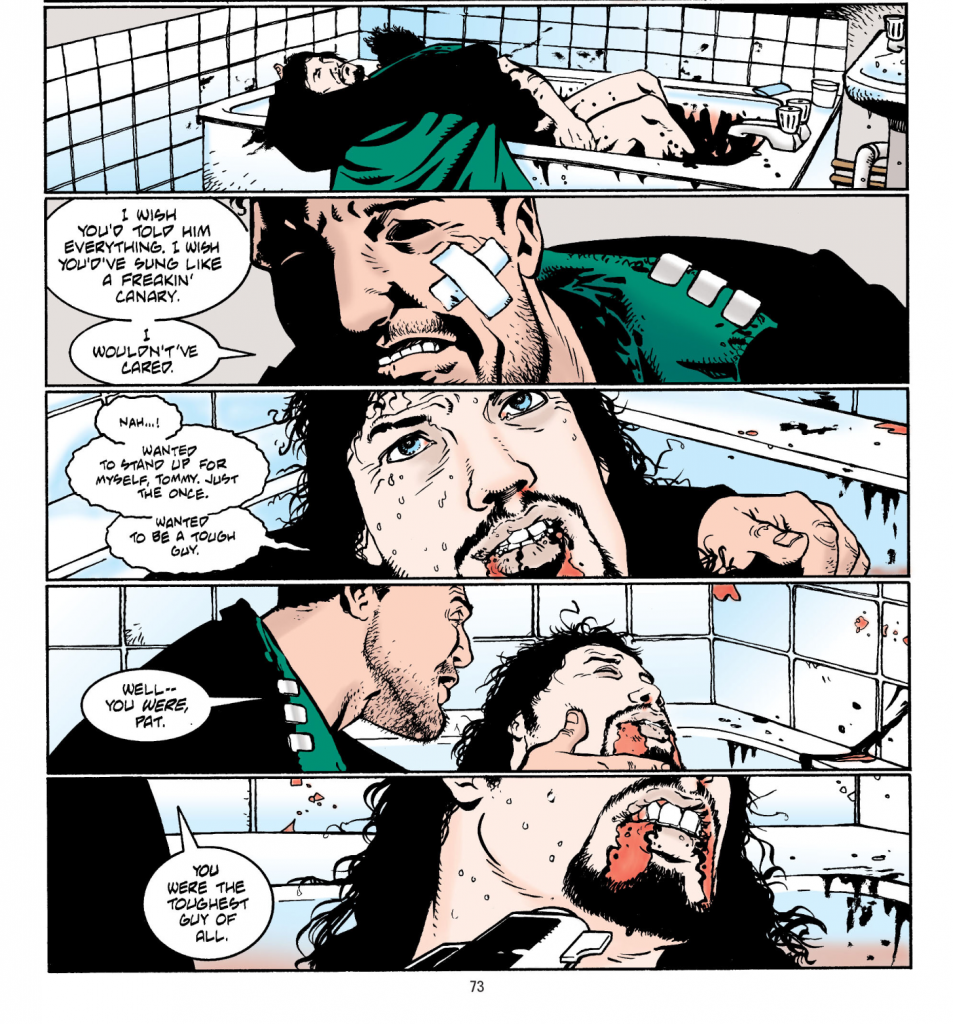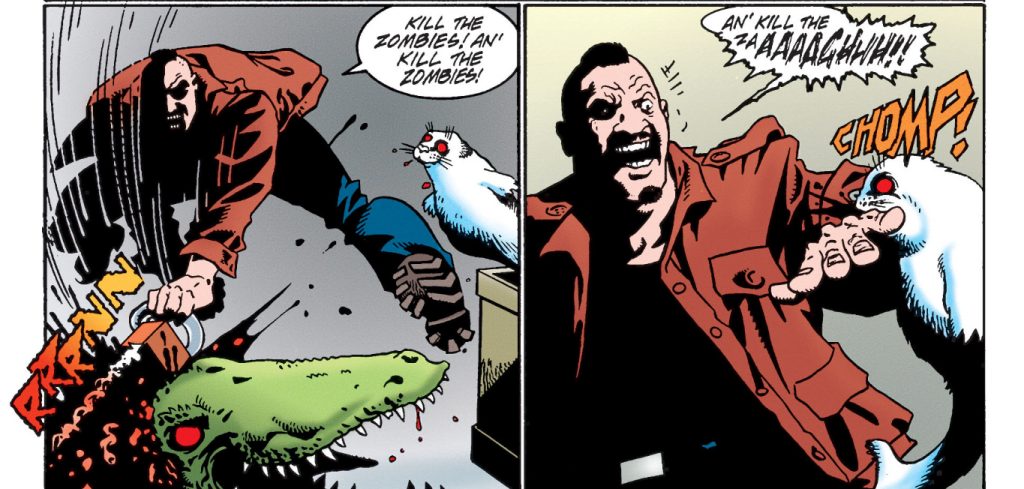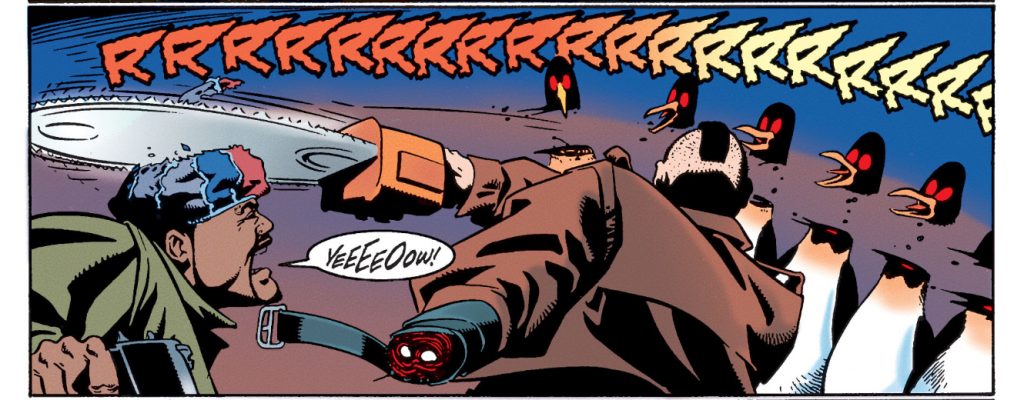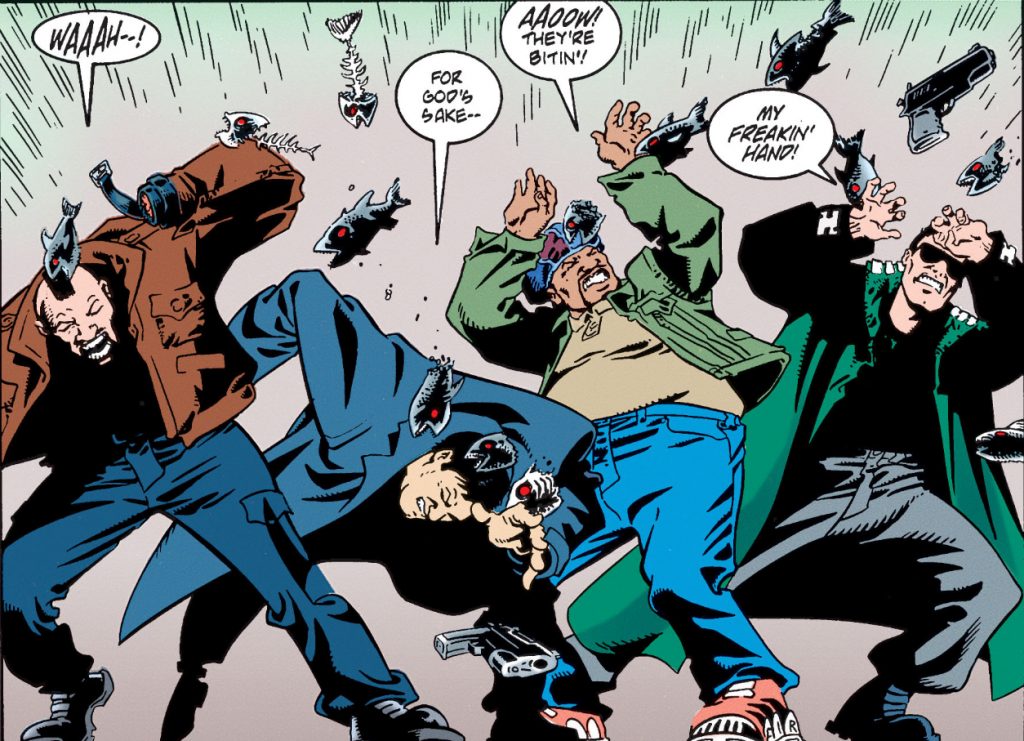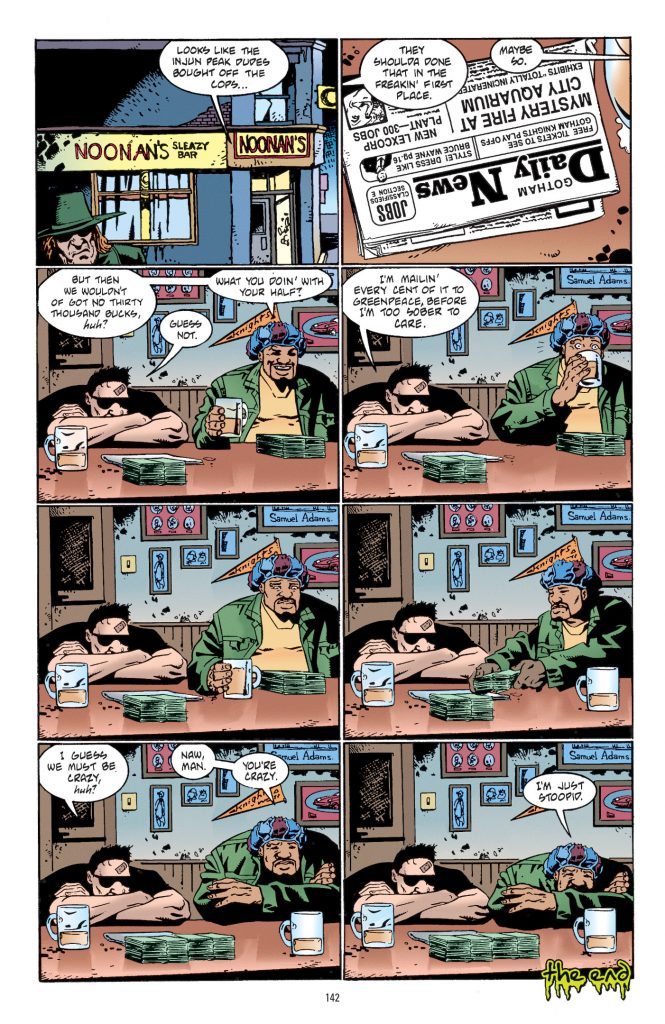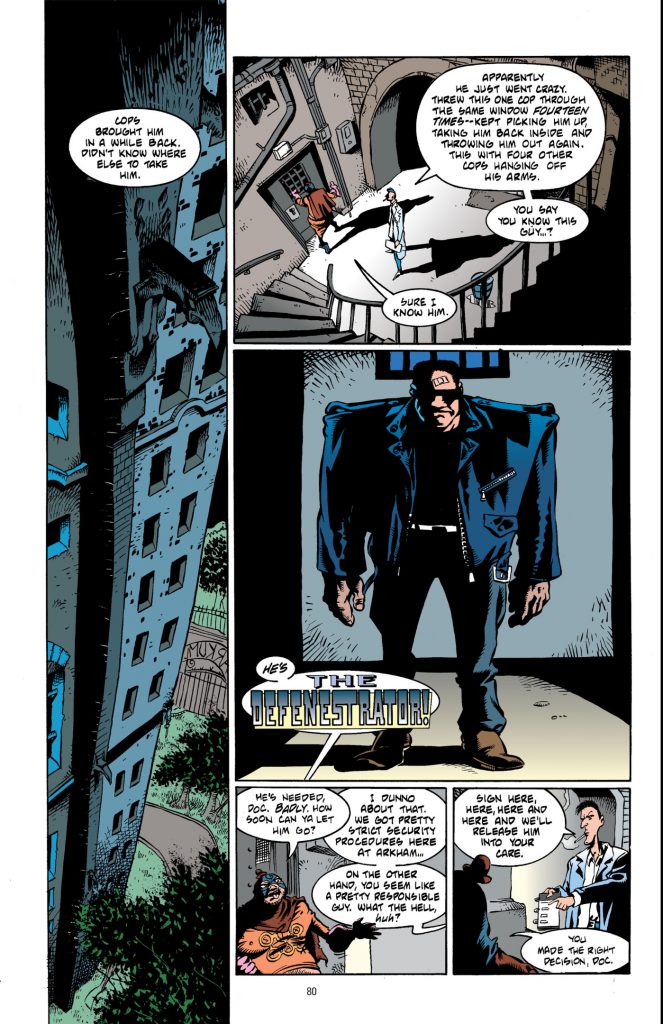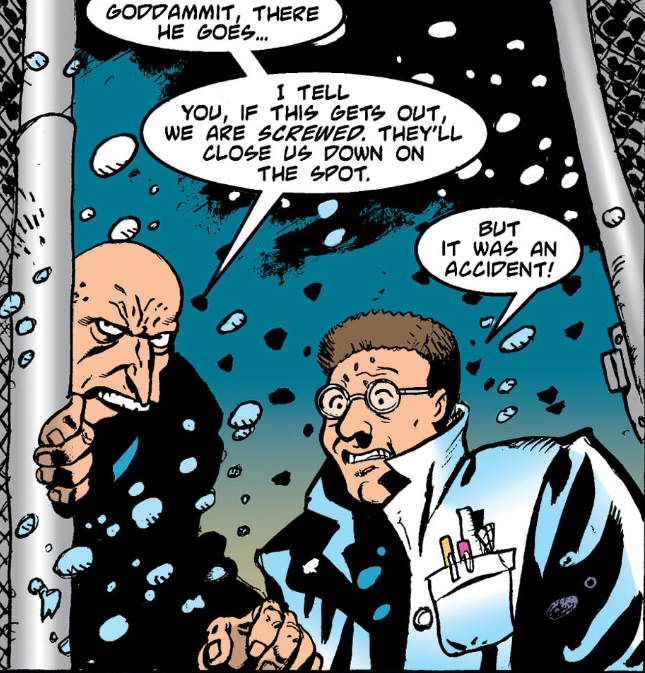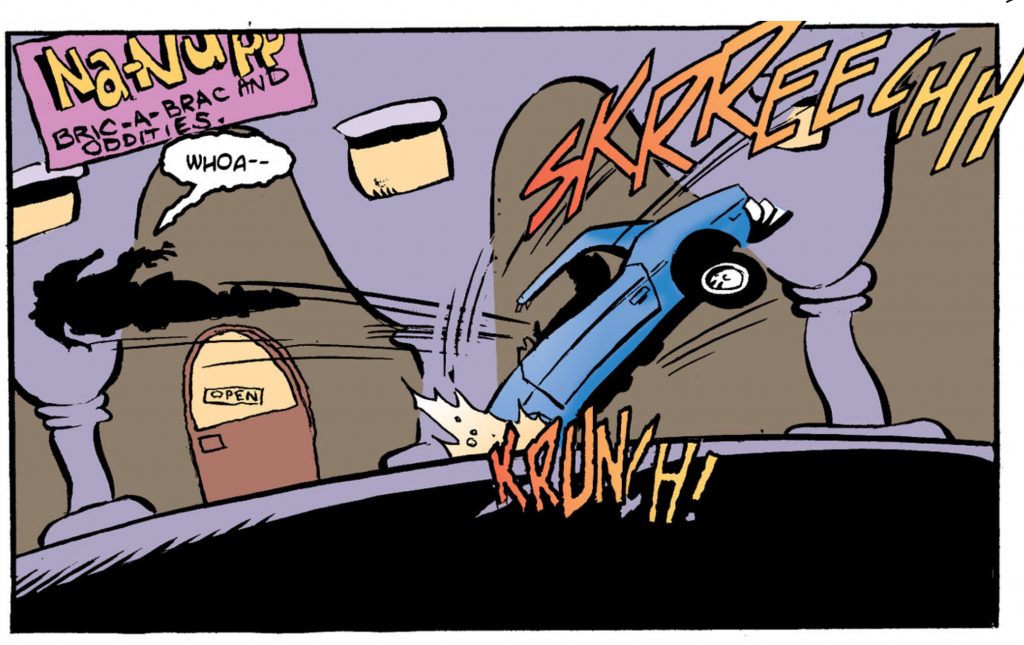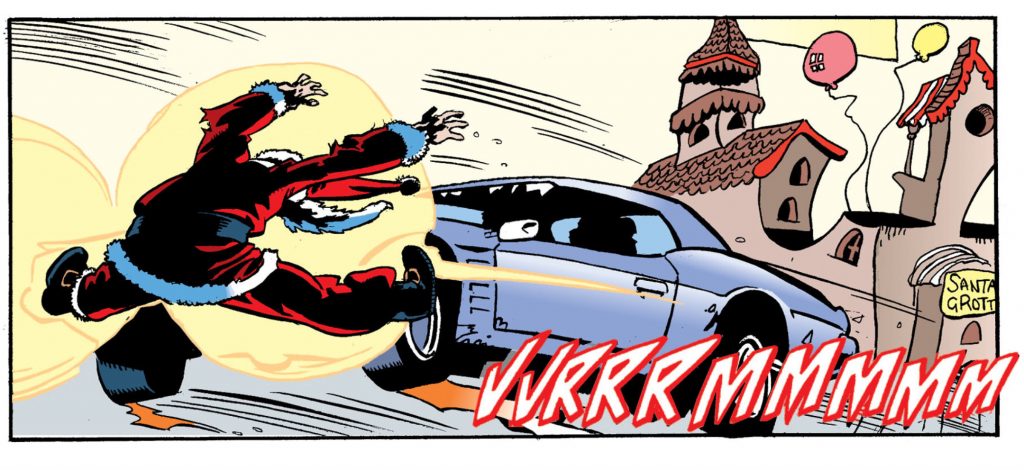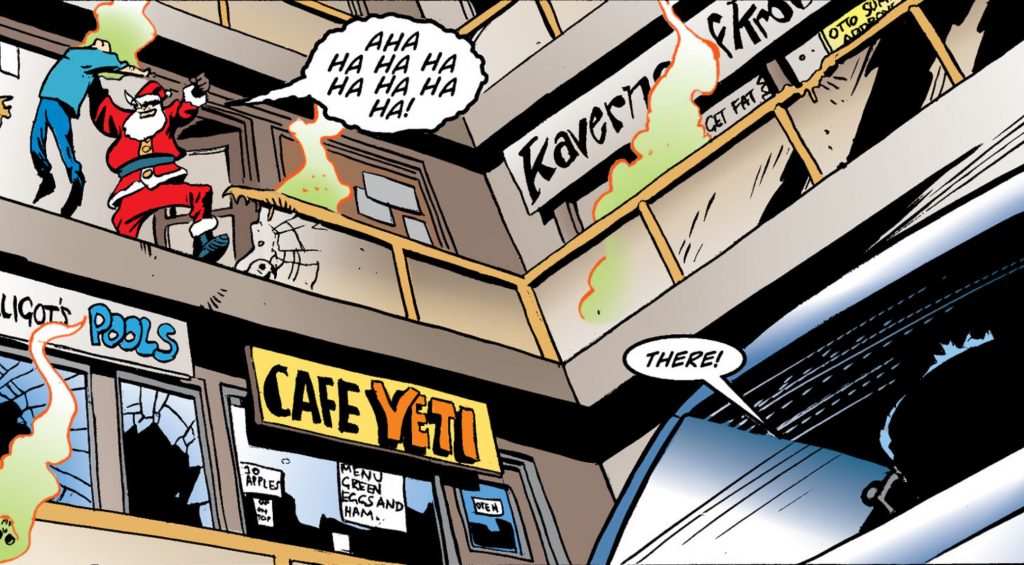A year ago, I talked about the paradoxes that drive The Boys author Garth Ennis’s work, and there’s no better example than Hitman. This is a story about the deadly and inescapable consequences of violence that also has its hero mow down the population of a small country in ever more improbably hilarious ways. (Ennis has said his first run on Marvel’s The Punisher was primarily influenced by Itchy and Scratchy, and it’s easy to see that same sense of cartoon mayhem here.)
It’s exhaustingly edgy in that very ‘90s way, and yet it cares deeply, passionately about its characters. It’s a story with the most profound emotional realism and the most outlandish nonsense — the hero was introduced in an issue of The Demon where a devil from hell uses cop cars to fence with a space alien without taking the passengers out first, and it keeps at about that level of absurdity right up to the end. One of its primary characters is a little man in a bowler hat and permanently soiled tights who drinks so heavily he’s convinced himself he’s a superhero, and it’ll still make you cry when you see what happens to him. It’s a lot, is what it is, and nearly all of it is brilliant.
That Demon issue was part of DC’s Bloodlines crossover, where the earth was invaded by alien parasites who ate human spinal fluid with the side effect that the survivors woke up with superpowers. No, I don’t know how that’s supposed to work either, but it was the ‘90s, so let’s just roll with it. One of those survivors was a Gotham City hitman named Tommy Monaghan, who ended up with telepathy and X-ray vision. The idea was writers could use this event to introduce new and hopefully profitable characters, but Tommy was, predictably, the only one to take off.
He took off enough to get his own series in 1996 after a few appearances in The Demon and a Batman special. Following Ennis to the series was Tommy’s cocreator John McCrea, who’d stay by his side to the end of the book’s half-decade run and beyond, through the epilogue miniseries JLA/Hitman, All-Star Section Eight (starring Sixpack, the little drunk in the bowler hat), and Sixpack and Dogwelder.
We’d seen bits and pieces of Tommy’s world in The Demon, but once he took the spotlight, Ennis and McCrea set to work fleshing it out. That would be the Cauldron, which is to Gotham as Gotham is to the rest of the country — the seediest, poorest, nastiest, most dangerous corner of Batman’s territory.
And the center of that world is Noonan’s Sleazy Bar, owned by Irish ex-assassin Sean Noonan, who keeps a gatling gun behind the bar. This is where Tommy hangs out with his buddies: Chinese master killer Ringo Chen, manchild wannabe killer Hacken, Noonan’s son Pat, Sixpack, and Natt the Hat, Tommy’s closest friend, who he stays with to the (very) bitter end. By the end of the run, thanks to another run-in with the Demon, another infernal creature named Baytor takes over behind the bar. Back when Groot was as verbose as they come, Baytor never said anything but “I am Baytor!” Where are those royalties, Marvel?
Hitman began with the logliney premise of a superpowered hitman who took on superpowered contracts, but that obviously wasn’t where Ennis’s interest lay. “Half the time,” he says, “I forgot he had the powers, and half the time I forgot he was supposed to kill superpowered people. It was really the story of Tommy and his friends.”
A crew of murderers for hire is pretty far from the paragons of virtue who dominate most of DC’s line. Heroism wasn’t trendy at the time, of course, but Hitman steers clear of the “no more mister nice guy” platitudes of the Razorwulves and Overkills of the world (I swear I made exactly 0% of those names up. In fact, there were actually two Overkills, so one of them had to take the more lawyer-friendly, and somehow even sillier, name “Overtkill.”)
No, Tommy’s a killer with a code. He won’t kill anyone who isn’t a killer himself. That’s nothing new. If you’re feeling unkind, you can call it cliché. But Ennis doesn’t leave it at that. Tommy spends half the run paying a heavy price for his clean conscience and the other half paying for the jobs he did agree to. He begins the series turning down an offer from a demon called the Mawzir to work for hell, and that comes back to bite him in Ace of Killers, one of the series’ most spectacularly carnage-filled storylines. His refusal to hunt superheroes for the CIA leads directly to the last stand that closes the book out.
Tommy’s victims may seem like no more than bloodbags, props for scenes of overwhelming ownage, but Ennis knows every death matters, even the silly ones. Tommy and Natt joke about their one kill from their time in the Marine Corps in the first Gulf War. What they thought were attacking Iraqis turn out to be elite fighters from the British SAS. The story as they tell it is pure splatstick, perfectly timed.
Equally hilarious, Tommy gets thrown out of his girlfriend Tiegel’s room naked when her mother unexpectedly shows up. The fire escape falls apart and deposits Tommy in the middle of a drug deal that quickly turns into a firefight when some poor bastard sets off the mobsters’ itchy (but not scratchy) trigger fingers by arriving with their happy meals. Even more hilarious.
But the consequences of these deaths are all deadly serious. Years later, Ennis brings back the first of those accidents in one of his most harrowing stories, Who Dares Wins. The mafia is also after Tommy after the fire escape incident, and the best he and Natt can think of is to let their enemies take each other out. It works for a while, but it also leads to the death of mob boss Men’s Room Louie, which will haunt Tommy until the end of the run and catch one of his closest friends in the crossfire.
In another story from the series’ last years, McCrea gives us a glorious image of well-earned ownage that spills out across two pages.
But Ennis can eat his cake and have it too. A few issues later, he examines the real horror behind that image with clear eyes.
And yet, the magic of Hitman is it doesn’t feel like a cheat. The catharsis and the horror coexist.
If all this makes you want to read Hitman for the first time and you don’t want to know what happens next, you’d better start now, because from here on in, we’re not dancing around spoilers.
If Ennis and McCrea begin Hitman with Tommy making decisions that will reverberate into the future, the next story already shows the price of his life in Ten Thousand Bullets (which I was shocked to find out was not named as a parody of Brian Azzarello and Eduardo Risso’s Vertigo series 100 Bullets, which wouldn’t even exist for another three years. Who knows, maybe this put the name in Azzarello’s head).
This is where we meet Natt and learn about their goof in the Gulf. Up until this point, the role of Tommy’s best friend belonged to Pat Noonan — along with his father, the only characters who have existed as long as Tommy has. So when a new guy who Monaghan claims is his best friend shows up out of nowhere and the narration over a scene of them walking away together announces, “And just like that, I signed my best friend’s death warrant,” it seems obvious Natt’s just there long enough to be offed.
But that would be too easy. The main plot of Ten Thousand Bullets concerns Johnny Navarone (the obvious pun that this makes his guns The Guns of Navarone remains implied), a hypercompetent hitman who the mob sends after Tommy to avenge the murder of one and a half (because brothers Moe and Joe are conjoined twins) of the Dubelz crime family in his first appearance. Already, the consequences are starting to pile up.
Tommy thinks he’s escaped Navarrone, but he returns to the room he shares with Pat to find him in a bathtub full of blood. He’s apparently been disemboweled or castrated or worse, and the fact that we can’t see makes it even more horrible. Here, for the first time, Ennis reveals the bleeding emotion that can exist side-by-side with the casual bloodshed, and it’s heartbreaking.
Tommy mourns in his own way. None of the Dubelz family survive the night.
Even in the series’ first year, Ennis was already showing off how skillfully he could weave the sublime and the ridiculous, introducing Nightfist (“He will hit you with his fist!”) a parody of Batman by way of EXTREME!!! ‘90s superheroes who fights criminals mostly so he can steal their dope and sell it himself. He’s a great character, too great to get killed off, but at least he dies as he lives — ridiculously.
The next storyline, Local Heroes, introduces Agent Truman, the man who will eventually end Tommy’s story, and includes a team-up with the Green Lantern who, true to Ennis’s famous annoyance with superheroes, doesn’t come out of it with too much dignity intact. After that, we get Zombie Night at the Gotham Aquarium, which introduces Tommy’s frequent employers at Injun Peak Research Center as Tommy takes out another one of their experiments gone wrong, a fleet of zombified sea creatures. Ennis and McCrea take that wild concept everywhere you’d expect, and a couple places you wouldn’t.
Hacken loses a hand, but don’t worry about that. McCrea forgets about it half the time anyway.
And that’s just a warmup for what comes next. In Ace of Killers, the Mawzir returns to make Tommy pay for turning down his offer and humiliating him pretty badly in the process. Just the opening salvo takes out most of the Gotham docks, and Tommy and Natt have to enlist Catwoman and their old friend Etrigan the Demon to get out alive. This was one of the three Hitman paperbacks I picked up on the cheap before I circled back to complete the whole series on Comixology, and I had to pick my jaw up of the floor every five minutes with every unpredictable new twist or spectacular moment of imaginative chaos Ennis and McCrea unleashed on me.
Most famously, this is where the authors reveal Sixpack may not be as delusional as he seems when he calls in his super team for backup. What we get are some of Ennis’s most demented creations, including Dogwelder, invented when Ennis and some pals went drinking and conceived a contest to create the stupid superhero imaginable, which his Preacher/Punisher collaborator Steve Dillon won on the first try.
There’s also Friendly Fire, who can shoot fire out of his hands but only at his own team, and the Defenestrator, a Terminator lookalike who throws his enemies out of windows (and, if they’re outdoors, carries a window around to bash them over the head with) and who Sixpack has a hilariously easy time recruiting:
But Ennis and McCrea had to come up with eight new heroes on the fly, so they can’t all be winners. Least winningest of all, there’s Bueno Excellente, a tasteless walking rape joke (“he fights crime with the power of perversion”) with a side dish of “Spanish is funny” who unfortunately seems to be one of Ennis’s favorites.
Fortunately, most of the absurdity lands a lot better. Hitman follows up Ace of Killers with a holiday tribute to Dr. Seuss in “The Santa Contract,” where Santa’s red-and-white furs are donned not by a Grinch but an irradiated grouch from a familiar-looking nuclear power plant:
Seuss might seem like a strange influence for such a hard-R-rated series, but if you’ve been paying attention to Etrigan’s rhyming dialogue, it should already by clear the great children’s author made an impression on Ennis. And the same goes for McCrea, who fills the background with Seussian architecture and other Easter eggs. The story gets some mileage out of the subversive thrill of putting Seuss’s story in such an adults-only context, but it’s also a surprisingly sincere homage, with plenty of deep cut references hidden in the corners of the narrative.
More importantly, it’s bloody hilarious.

